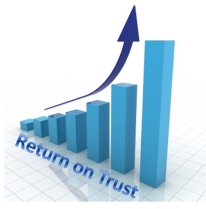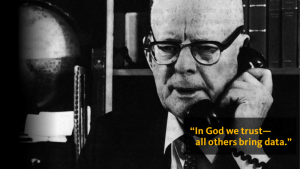What’s Your ROT – Return on Trust?
As leaders and managers we are programmed through education and experience to constantly measure and manage the results of our activities. Want to make a new capital investment? You better perform a cost/benefit analysis. Need to assess the effectiveness of a particular business strategy? Figure out the ROI – Return on Investment. If it’s important to our business then we have to be able to measure it. That’s our motto.
But what about trust? How do you measure the impact of trust, positively or negatively, on your business? What’s your ROT – Return on Trust?
Most leaders I speak with agree that trust is important but they often think it’s just another one of those “soft” people issues like engagement, empowerment, well-being, or morale. They think trust “just happens,” as if through some sort of relationship osmosis, and they certainly don’t think you can measure it.
They’re wrong. You can measure trust, but you have to know where to look and understand how it shows up in organizations.
What Trust Looks Like in Organizations
- People keep their commitments and are consistent in their behavior
- Risk taking is encouraged and rewarded
- People feel safe in sharing their ideas and opinions
- Team members have a shared sense of responsibility and commitment to the organization
- People are treated equitably and ethically, regardless of their position or rank
- The culture promotes and rewards honesty and ethical behavior
- Senior leadership communicates transparently and authentically
- Mistakes are viewed as “learning opportunities” rather than mortal failures
- People feel valued and are engaged in their work
- Productivity and creativity flourishes
Return on Trust
Interpersonal trust is developed through the use of very specific behaviors that demonstrate your competence, integrity, value for relationships, and dependability. Organizational trust is developed through the use of sound, common-sense business practices that align with the organization’s values, prioritize the value of human worth in the workplace, foster transparency and accountability, and emphasize customer loyalty and retention.
 You can measure ROT by using common sense, as an executive of one of the world’s largest home improvement retailers shared with me. He said that in his 22 year experience with the company, the teams and stores that had the highest levels of trust consistently recorded the lowest people costs around turnover, accidents, and inventory shrink. They also achieved the highest revenues, profits, and employee engagement and customer satisfaction scores.
You can measure ROT by using common sense, as an executive of one of the world’s largest home improvement retailers shared with me. He said that in his 22 year experience with the company, the teams and stores that had the highest levels of trust consistently recorded the lowest people costs around turnover, accidents, and inventory shrink. They also achieved the highest revenues, profits, and employee engagement and customer satisfaction scores.
You can also measure ROT by examining the financial performance of high-trust organizations. Research by the Great Places to Work Institute, publisher of the Fortune 100 Best Companies to Work For list, has shown that between 1997-2011, high trust companies outperformed the Russell 3000 and S&P 500, posting annualized returns of 10.32% versus 4.02% and 3.71%, respectively. Additionally, those best companies provide 4 times the returns than market average for comparative low-trust companies and typically experience a 50% lower turnover rate.
Whether you see the everyday, common sense results of high levels of trust, or you evaluate the financial metrics of high-performing/high-trust companies, Return on Trust is something every leader should measure.

No comments:
Post a Comment